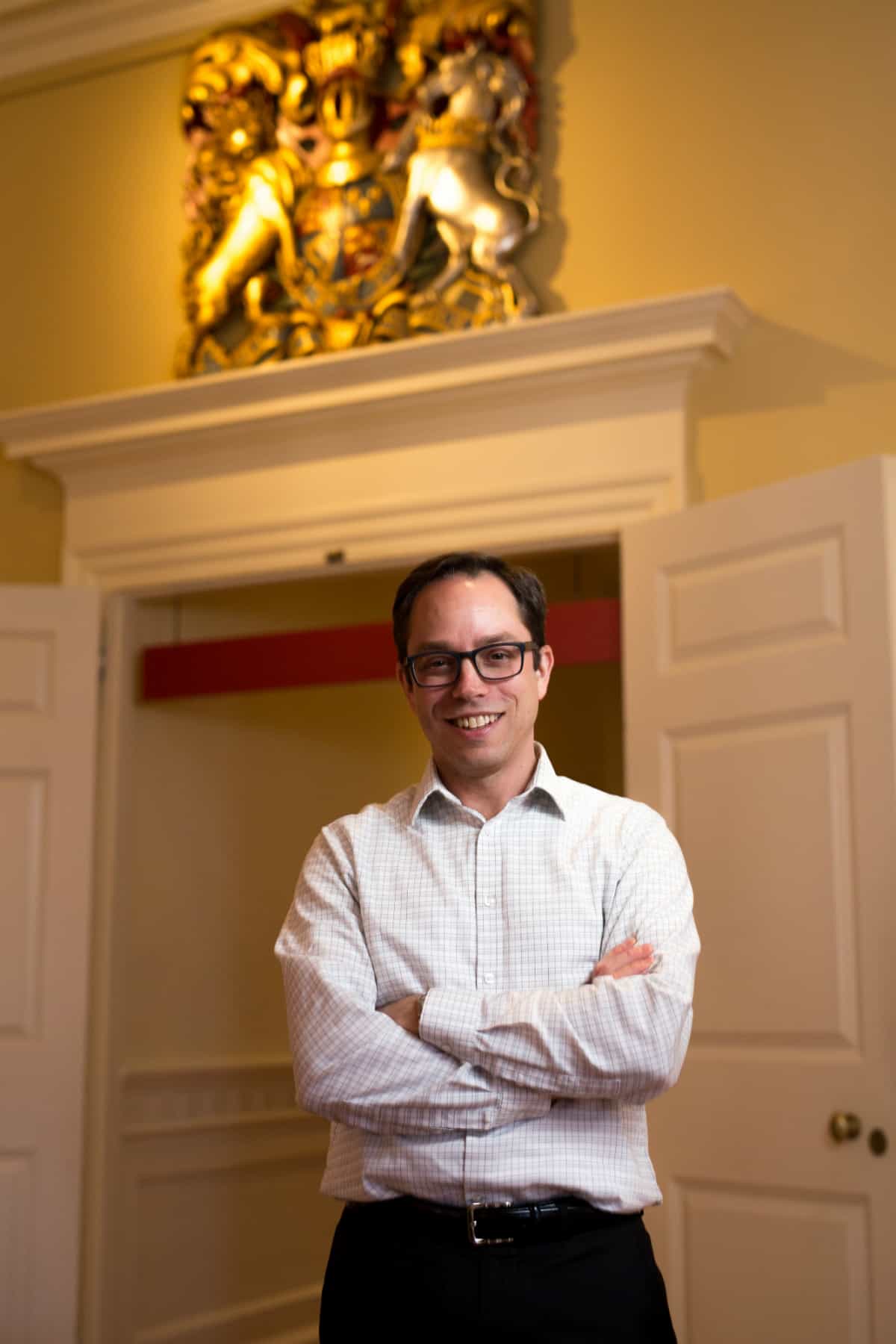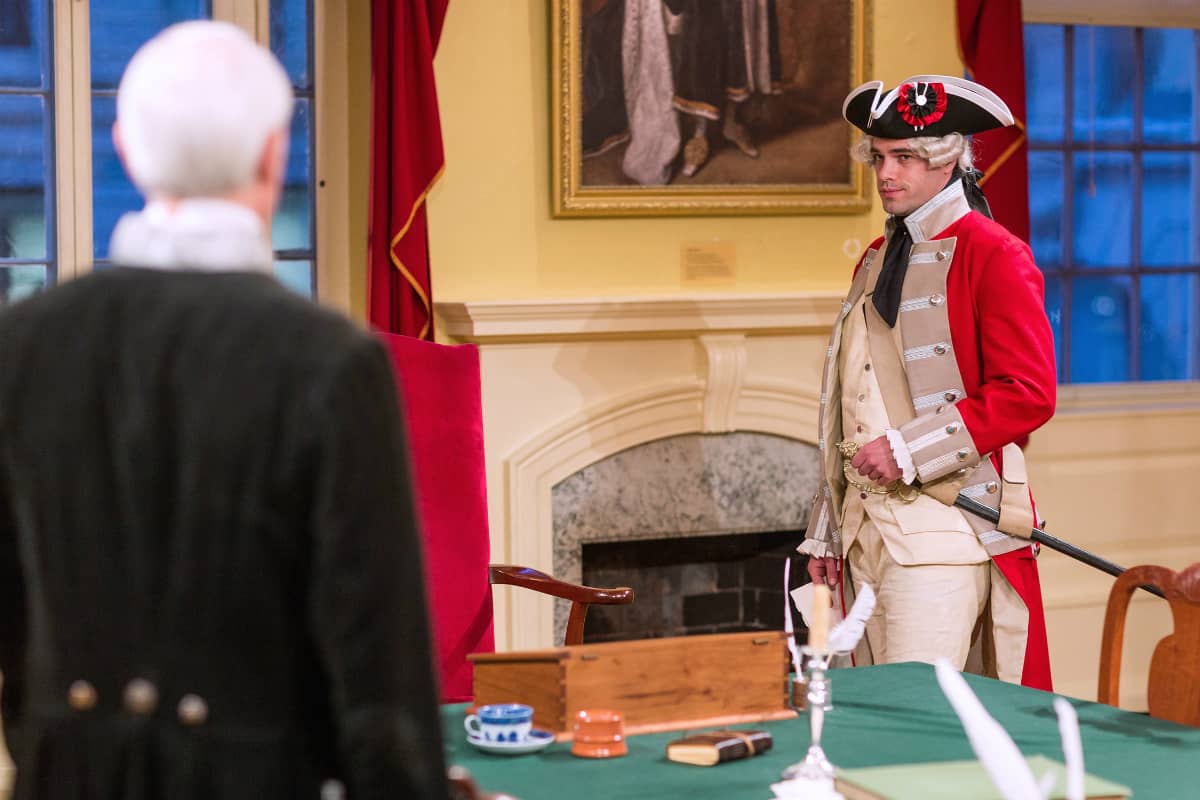Bostonian Society Executive Director Nat Sheidley wants to turn a seat of colonial power into a beacon of civic empowerment.
Boston’s oldest public building stands, rather undignified, atop the entrance of a subway station. The Old State House, operated by the once staid Bostonian Society since 1881, loomed large in the early days of America. Today it rests in the shade of younger, more imposing buildings, overlooked by all but the most Freedom Trail-oriented visitors of New England’s capital.
In April, the Bostonian Society took steps to modernize its image, elevating Nat Sheidley, a programmatically daring historian with a penchant for immersive experiences to executive director. Using top-flight theater talent, a newly renovated council chamber that doubles as a theater, and a refreshing willingness to take risks, Sheidley hopes to make the Old State House a place where visitors can grapple with today’s most complex issues, from terrorism to body cameras, through the historical lens of who speaks for us, and how we can speak for ourselves.
Sheidley, 49, earned his PhD at Princeton and took a tenure-track turn at Wellesley College before jumping off the rails to the less predictable path of public history. At Bostonian, he found his calling in the “collective enterprise of working together to figure out why history matters and why it speaks to the present.”
Blood in the Snow, the Boston Massacre-themed play that Sheidley created with playwright Patrick Gabridge, recently wrapped after a near capacity twelve-week run. After an exhausting tourist season, he’s ready to talk about the future of Bostonian Society, but he suggests that he’d prefer to do it over a pint.

Nat Sheidley, Justin Saglio photo
Take: The Old State House is traditionally known as a museum that tourists go to rather than locals. How do you see your space as relevant to the Bostonian and the New Englander?
Nat Sheidley: It is specific to the American experience. I think of the Old State House as perhaps the most important wellspring from which the fundamental American conversation has flowed: Who gets to speak for me? How wide do we draw the circle of “we” in “we, the people?” This is where that debate began. We still have that. We have that debate in every neighborhood in Boston. It still animates our local politics, it animates our regional politics, it animates our state politics and certainly our national politics right now. If you come to the Old State House, you can touch a place where that argument took shape, and I think it’s valuable for us to remember in highly divided times that we’re still bound together by having this conversation. People have been arguing about these questions for 250 years, and the Old State House can deepen the contemporary conversation by providing some historical context and by providing people with an opportunity to touch a place of origin. I just think it deepens our sense of what’s at stake and what matters.
T: Why did you choose theater as the medium to relay the stories of the Old State House? What role do you see theater playing in this museum?
NS: The history that we are involved in sharing with visitors at our site is so steeped in mythology that most of our visitors tend to see the human beings who made that history as not human beings at all but mythic figures; sort of godlike figures who could do no wrong, who are only two-dimensional. It was important to us to help folks see that even this incredibly important moment in the nation was made by human beings who had no idea what they were doing. They were muddling through it and trying to navigate an incredibly difficult moment to the best of their ability. But they had all the same emotional challenges — the anger, the grief — all the same things that we deal with as human beings today. Theater was a great vehicle to get us out of the mythology and really thinking about these individuals as three-dimensional people. It makes the history feel so much more immediate and understandable from that perspective.
T: Where do you see the parallels between the history you’re relaying and the world today?
NS: This past summer, there was a huge protest on Boston Common around the free speech rally after what had happened in Charlottesville. There was a sense that there was a lot at stake as to who we are as Bostonians and as a people, as a country. A lot of folks came to Boston to counter-protest, and some of them came to the Old State House. I was able to spend most of the day at the building, and standing, in particular, in front of a case on our first floor that tells the story of the protests that happened at the Liberty Tree in August of 1765. To me, it seemed like just an incredible resonance between past and present. The revolution was born of people taking to the streets to express their values and their sense of justice and equality, and here we were 250 years or more later, people still taking to the streets to stand up for what they believe in. What greater resonance is there between the revolutionary period and our own? We still have a lot to learn from the past, and I think a really thoughtful encounter with the past can help us understand our present better.
T: What do you hope to bring with your new role as executive director? What makes you the right person for this moment?
NS: I’m not willing to settle for what’s easy or for what we know will succeed. I know we can do better. I think it might take a willingness to experiment and take risks. Even though some of the things we try may fail, there’s so much more we can do to provide a meaningful experience of the past for people in a way that really opens up a new understanding of the present; getting there takes a commitment to experimentation and a willingness to try new methodologies. I hope my interest in doing that will have an impact.
T: What kinds of programming is the Old State House planning to make the space more of a cultural touchstone in the Boston area?
NS: Next year our programming will center on a remarkable object in our museum collection. We have the original door to John Hancock’s house, and we’re working with the preservation carpentry program at North Bennet Street School to restore it. They’re going to reconstruct the entire doorway, and it will come to the museum for display. What I’d love to do is give people a chance to step through it for the first time since the 1860s. Wouldn’t that be transporting? We’re still working out the details, but in our programming we’ll use the metaphor of a doorway to engage a wider audience in Boston to think about the barriers that divide us, and the doors that we’d like to see opened in our community that aren’t open right now.
Nat Sheidley – Executive Director of the Bostonian Society
Boston, Massachusetts
Website
Facebook
Twitter
Instagram
Top image: Performance of Bostonian Society’s Blood in the Snow. Photo by Nile Hawver.








